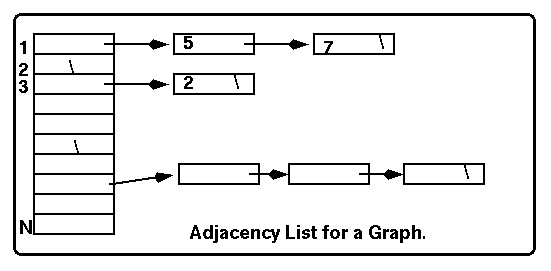 5.5. Representations for Graphs.
5.5. Representations for Graphs.  5.5. Representations for Graphs.
5.5. Representations for Graphs. What information does a graph possess?

vertices and their names
edges and their labels/ weights
direction of the arc
connectivity how many edges at each node.


Is it possible to go from Perth to Hobart by train?
Is the circuit diagram totally connected or is a component
dangling unconnected?
What is the shortest/ fastest/ cheapest route from A to B?

Also depends upon whether we want all the information above
to be stored explicitly. If the vertex names are mapped into
integers 1..V then a square matrix [1..V,1..V] can be constructed
which shows the adjacency of each node: i.e A[x,y] is TRUE or has
a value(=weight) if there is an edge between node x and node y.
Note a direct line not a path. It is FALSE or has an
"unconnected" value otherwise.

P M S N H L C
P 1 1 0 0 0 0 0
M 1 1 1 0 0 0 1 COST
S 0 1 1 1 0 0 1 A B C
N 0 0 1 1 0 0 0 A 0 inf 10
H 0 0 0 0 1 1 0 B inf 0 5
L 0 0 0 0 1 1 0 C 10 5 0
C 0 1 1 0 0 0 1


Cost of 0 to not go (ie journey to place you are at) and
infinite cost to go to someplace you cannot go
( no rail service from Canberra to Hobart).


array[1..V,1..V] of boolean; or
array[1..V,1..V] of weights/values/costs;

An example of the use of the matrix is :

Test a[P,H]. 0=>no direct link.
What of indirect links?
Test a[P,M]. 1 => we can go to Melbourne.
Test a[M,H]. 0=> not from Melbourne.
Test a[P,S]. 0 => not to Sydney.
Test a[P,N]. 0 => not to Newcastle.
Test a[P,L]. 0 => not to Launceston.
Test a[P,C]. 0 => not to Canberra.


To avoid this O(V-squared) problem we can use an adjacency
list rather than a matrix to hold the graph.

Note that this indicates that an edge occurs between nodes
1 and 5 and nodes 1 and 7. An edge occurs between 3 and 2 but
not between 2 and 3: it represents a directed graph. Now our
algorithm to create the list need not be O(V-squared) and depends
on whether it is a directed graph and how sparse or dense it is.
As before other information can be added to represent weights,
etc. 
Many of our original questions about graphs can be answered by traversing the graph. A Depth-First algorithm can be used for this. In doing this we must keep track of every vertex visited: we use an array [1..V] of (visited,not_visited). Initially we set the entire array to not_visited and then systematically visit each node and set to visited.
Alternatively we may wish to initialise the array to 0 and
then visit the n-th node and set array[node] = n.

begin
n0;
for k1 to v do matrix[k]
0;
for k1 to v do
if matrix[k] = 0 then visit(k)
end;


procedure visit(integer k);
var
t:integer;
begin
nn+1;
matrix[k]n;
for t1 to v do
if a[k,t] then
/* use adjacency matrix to determine
which node to visit next. */
if matrix[t] = 0 then
/* Not visited yet therefore: */
visit(t);
end;

Question: does a graph have a cycle?

We get the answer from visit:
iff a non-zero matrix entry is discovered in visit procedure.
That is, we find an edge that has already been visited.


Each non-recursive call to visit corresponds to a different
connected component. All connected nodes are visited at each
recursive call because the visit algorithm searches out
all connected nodes!!!

There is also a breadth-first search algorithm. Rather than go as deep(recursively) as you can down the graph structure and then work back upwards, we would visit each node at the top "level" , and then each node at next level, etc The two algorithms are good for different applications and analysis of each can be found in most standard text books.










